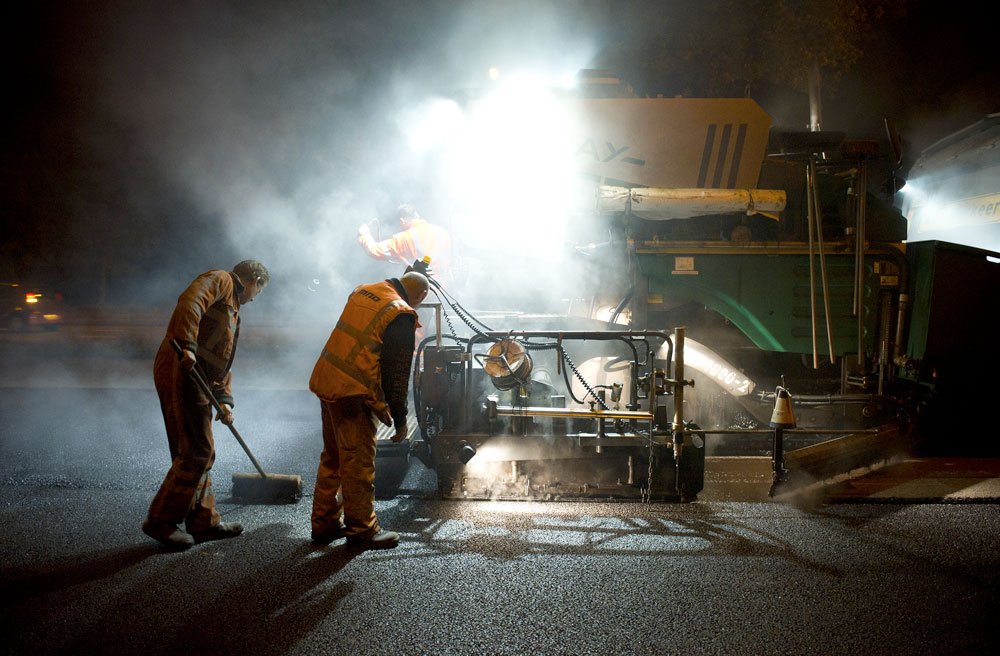It’s been a busy week for Professor Molenaar (CEGS), having three PhD defences under his supervision. So is Road Engineering such a booming discipline? Well, it depends.
On Monday, Dr Gang Liu, from China, defended his thesis on mixing clay into bitumen. On Tuesday, Dr Milliyan Woldekidan, from Ethiopia, presented his computer model on aging asphalt, and on Wednesday, Dr Wim van den Bergh, from Belgium, showed how asphalt quality can be maintained despite up to 50 percent recycling of the old asphalt.
This week’s trio is a fair representation of Professor Andre Molenaar’s section at Civil Engineering and Geosciences. He has only three MSc students (“Road Building isn’t regarded as attractive or sexy,” Molenaar says) but 18 PhD students originating from places ranging from China to Chile. Innovations in ‘Dutch Road Engineering’, advanced and reputable as it may be, are mostly developed by foreign minds.
“I try to make the sword cut from both sides,” the professor says. A foreign PhD student will benefit the road engineering in his homeland when he returns. But the Netherlands needs well-trained people, too. Someone needs to take the place of the senior baby-boomers who are now about to retire. That’s why Molenaar tries to convince some foreign PhD students to remain in the Netherlands.
The Netherlands has some peculiarities in road engineering. One is the high (over 80 percent) share of Porous Asphalt (Zoab in Dutch) on the roads. Another is the large portion of recycled material in new or renewed roads. Molenaar explains: “Road building in the Netherlands usually means renewing an existing road. All the material that comes off the road should be recycled back. We cannot just dump it.” Much of the research is directed towards slowing down the aging of asphalt and making it last longer.
So, what is asphalt made from? Basically, it’s a collection of stones and sand (called aggregate, 95 weight percent) held together with 5 weight percent asphalt cement consisting mainly of bitumen (a residue from crude oil refining). Widespread and popular as it may be, asphalt starts aging from the moment it is laid. UV-radiation and oxidation attack the viscous bonds in bitumen, which hold the matrix together. Lighter components from the bitumen evaporate, making the residue harder and stiffer. Heat and frost add their share, just as the continuous vibrations from the traffic passing over it. In all, most roads will last a little over a decade before little stones become detached, holes emerge in the top layer and refurbishment is needed, causing hindrances for passing traffic. No wonder then that prolonging asphalt lifetime is a fertile subject for research.
Dr Gang Liu studied the possibilities for improving bitumen quality by adding 20-micron clay particles. The clay has been modified to make it mix with the hydrophobic bitumen. Prof. Molenaar: “The idea originated from experiences with polymers where adding clay particles generally improved the strength, stiffness and toughness of the material. We wanted to see if the same happened to bitumen, which, after all, is a polymer as well.” Liu found that adding clay to bitumen delays the aging process and makes the bitumen more viscous, meaning it will sag less under its own weight. Molenaar expects the average lifetime of 11 years to increase by 2 to 3 years.
Other additives have been contemplated as well, such as polyurethane or epoxy as a binding agent. The question is how well they will perform over the years under realistic circumstances. The computer model that Dr Milliyon Woldekidan developed allows a prediction of the lifetime of various mortar compositions. Molenaar says the model gets the ranking pretty well. This means that companies can now test their recipes in a mathematical model before putting it ‘on the road’.
Finally, how to cope with all that recycled material and still maintain bitumen’s self-healing properties? “Bitumen has the unique property that if you put two pieces together again, the plane of the crack will grow over and heal,” Molenaar explains. Does that also happen with old recycled material? Dr Wim van den Bergh has shown that the self-healing properties will indeed be less in recycled material. For road design this means that the recycled layer should be made a little (10 percent) thicker, and the top layer should be made from new material.
Best to know such things in advance.
Het kabinet liet weten geen afstand te willen nemen van de omstreden maatregelen.
Oppositieleiders riepen daarop op het Malieveld de demonstranten op om bij de komende verkiezingen voor de Provinciale Staten op oppositiepartijen te stemmen. Immers, de Staten kiezen de leden van de Eerste Kamer die dan de omstreden wet tegen zouden kunnen houden.



Comments are closed.